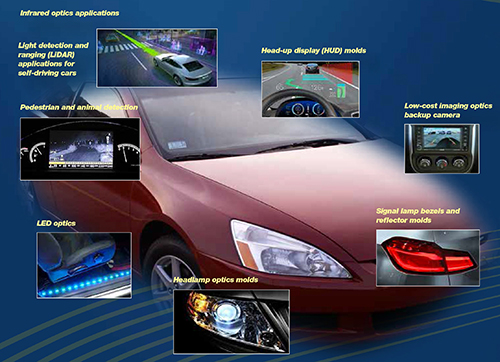
Precitech has seen a recent increase in the use of ultra-precision machining techniques in the automotive industry. Many of the hardware and software features that they have developed over the years can be used to manufacturer components for automotive applications. AZO Network recently conducted an interview with Jeff Roblee, VP of Technology, and Ed Freyenhagen, Director of Engineering on this topic. Here are some excerpts from the interview “Precitech Solutions for the Automotive Industry.” (full interview)
AZO: Why are your customers starting to use ultra‑precision manufacturing techniques more these days for automotive applications?
EF: There are many new features that automobile companies are developing into their products to enhance them and add functionality. Many of these new features require or can be made better by using ultra‑precision manufacturing techniques.
AZO: What are some of these new applications and how does ultra‑precision bring value to them?
JR: The most interesting automotive applications that we commonly see are for head up displays (HUDs). Newer applications include ones, such as infrared optics for LIDAR (light detection and ranging) systems for self‑driving vehicles, and animal and people detection systems. Also, cars are now coming with cameras for backup and parking assistance, which require imaging optics. Still other applications are being improved with ultra‑precision manufacturing techniques, such as LEDs for enhanced interior illumination, signal lamp bezels, and headlamp optics.
AZO: What key technologies enable ultra-precision machine tools to be used for automotive applications?
EF: As Jeff mentioned, two key technologies for turning operations are fast tool servo (FTS) and adaptive control technology (ACT). One that Jeff did not mention is ultra‑precision milling, which is another method to make freeform shapes on molds required for headlamp optics. For some mold patterns, due to the physical limitation in the shape of diamond tools, milling may be required instead of the faster turning process.
AZO: With regards to fast tool servo (FTS) and milling technologies what are the key considerations one should be aware of when manufacturing headlamp molds?
EF: For FTS applications, it is all about speed and accuracy. With a peak acceleration of 30 Gs and a fully integrated programming and operating interface, the Precitech fast tool servo with Fastcom III control has benefits in both these areas. The story for milling is the same: speed and accuracy are critical considerations. The Levicron milling spindle has a top speed of 80,000 rpm, which is faster than other ultra precision milling spindles. It is extremely thermally stable and has low-error motions, making it highly accurate.
For more information, visit www.precitech.com
